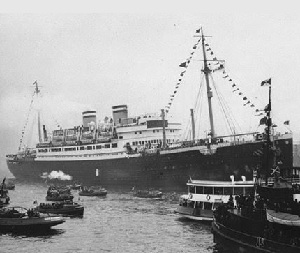 This is a scary story. In May 1939 more than 900 Jews who arrived in the port of Havana on board the ship Saint Louis, which came from Nazi Germany, were prevented from disembarking despite the fact that they all had the proper authorization to do so, a so-called landing permit for which they paid a minimum of $150.
This is a scary story. In May 1939 more than 900 Jews who arrived in the port of Havana on board the ship Saint Louis, which came from Nazi Germany, were prevented from disembarking despite the fact that they all had the proper authorization to do so, a so-called landing permit for which they paid a minimum of $150.
Almost all of them had applied for a visa to the United States and intended to remain on the island only until they could enter the country. But eight days before the Saint Louis set sail for Cuba from the German port of Hamburg, Cuban President Federico Laredo Bru, by a decree, invalidated the landing permits. To enter Cuba it would then be compulsory to have an authorization from the Secretary of State and another from the Secretary of Labor, plus the payment of a $500 bonus, requirements from which, of course, tourists were excluded. None of the passengers on the Saint Louis knew about the entry into force of this measure until they arrived at the port of Havana. And it was too late. They had to return to Europe. Not many of them survived to tell the story.
In short, only 28 of the 937 passengers on the Saint Louis were able to disembark in Havana on May 27, 1939, after a two-week voyage. Six of them (four Spaniards and two Cubans) were not Jewish, and among these, only 22 were able to show the new documentation required for the landing. One more passenger, a Jew, attempted suicide on board and was rushed to a Havana hospital. It was never known whether he was returned to the ship or left on land.
One day after the arrival of the Jews to the Havana port, Lawrence Berenson, lawyer of the American Jewish Committee for Joint Distribution (JDC), arrived in Havana to intercede for the passengers. He had been president of the Cuban-American Chamber of Commerce and therefore had many relations and extensive business experience in Cuba. He met with Laredo Bru and tried to convince him to authorize the landing. The President persisted in his refusal. On June 2, the President ordered the Saint Louis to leave Cuban waters, but he did not cut off the talks with Berenson, from whom he asked for $435,500 in exchange for letting the passengers disembark. The negotiator made a counteroffer; Laredo Bru rejected it and broke off contacts.
Inés and Renata look sadly through the porthole of the transatlantic, one of the most famous pictures of the trip. Photo: the Andalusian Post Office.
Meanwhile, the St. Louis slowly sailed to the United States. They sent a telegram to President Franklin Delano Roosevelt requesting refuge. Roosevelt never responded. Already the White House and the State Department had decided not to allow them entry. They had to, said American diplomatic sources, wait their turn on the waiting list and then meet the necessary requirements to obtain an emigration visa in order to be admitted to U.S. territory.
After Washington’s refusal, the Saint Louis set out for Europe. Some of the passengers were admitted to Great Britain, Holland and France. The rest disembarked in Antwerp on June 17, 1939, after spending more than a month at sea. The French, Belgian and Dutch authorities took them to internment camps, as well as to other German refugees. The British authorities interned them on the Isle of Man and in confinement camps in Canada and Australia. With the German invasion of Western Europe in May 1940, the passengers of the Saint Louis were again in danger. Some 670 of them fell into the hands of the Nazis and died in concentration camps. Another 240 survived years of hunger, abuse and forced labor.
The Saint Louis was not the only ship with Jews on board to suffer this fate in Havana harbor. The same thing happened to other ships.
On May 27, 1939, the same day as the arrival of the Saint Louis, the English ship Orduña touched down in Havana, with 120 Austrian, Czech and German Jews on board. Forty-eight of these passengers carried landing permits that had been invalidated by the national authorities. They were still able to go ashore. The remaining 72 were forced to make a long pilgrimage through South America.
Also in May 1939 the French ship Flandre arrived in Havana, with 104 Jews on board. Landing was impossible. The Flandre returned to France, where the government accepted the emigrants but placed them in an internment camp.
Another ship, the Orinoco, twin of the Saint Louis, was due to arrive in Havana in June with 200 passengers on board. But when her captain heard about what was happening in that port, he tried to get England and France to take them in. They were not accepted, and neither was the United States. U.S. diplomats then pressured the German ambassador in London to give guarantees that once the refugees returned to Germany they would not be victims of Nazi barbarism. Those 200 Jews returned to Germany in June 1939. Their fate is still unknown.
(By Ciro Bianchi Ross)